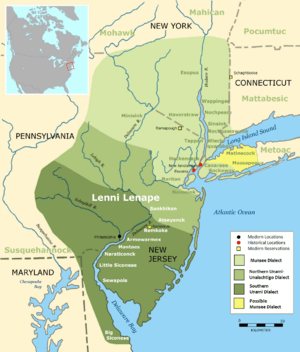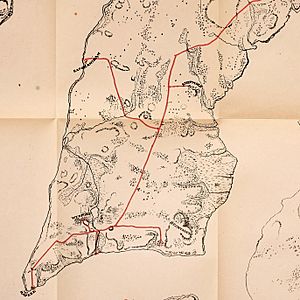Lenapehoking facts for kids
Lenapehoking (in the Unami dialect: Lënapehòkink) means 'homelands of the Lenape people'. In the 1500s and 1600s, this area stretched along the Eastern seaboard. It went from western Connecticut down to Delaware. It also included the lands around the Delaware River and the lower Hudson River, plus the area between them.
Starting in the 1600s, European settlers began moving onto traditional Lenape lands. At the same time, new diseases from Europe spread, and the colonists took more land. This caused the Lenape population to shrink greatly, and they lost control of much of Lenapehoking. In the 1700s and 1800s, the United States government forced many Lenape people to move. They were removed to the American Midwest, including the state of Oklahoma.
Today, Lenape nations have control over lands in Oklahoma (the Delaware Nation and Delaware Tribe of Indians). They also have lands in Wisconsin (the Stockbridge-Munsee Community) and in Ontario, Canada (the Munsee-Delaware Nation, Moravian of the Thames First Nation, and Delaware of Six Nations).
Contents
Understanding the Name Lenapehoking
Lenape people living in Oklahoma used the term Lenapehoking for their old homelands in the Northeast. It means 'in the land of the Lenape'. This name became well-known after Nora Thompson Dean shared it in 1970. Later, Herbert C. Kraft also helped to spread the word. Today, you can find this term in many books about the Lenape and in museums in New York.
Another old Lenape name for much of this same area was Scheyischbi. This name is often said to refer specifically to the land that is now New Jersey.
Where Lenapehoking Was Located
When Europeans first arrived in the 1500s and 1600s, the Lenape homeland stretched along the Atlantic coast. It went from western Connecticut all the way to Delaware. This area included the lands next to the Delaware River and the lower Hudson River valleys. It also covered the hilly and ridged land between these rivers.
The Lenape were related to other Algonquian tribes who lived along the entire coast. These tribes ranged from Canada down to northern South Carolina. The Lenape Confederation itself reached from southern Delaware along the Atlantic coast into western Long Island and Connecticut. It then went west across the Hudson water gap into the eastern Catskills. This part of the Appalachians was around the start of the Delaware River. The Lenape also lived along both sides of the Delaware River basin down to the mouth of the Lehigh River.
Inland, the Lenape shared land with the strong Susquehannock tribe. The Lenape territory often followed mountain ridges and drainage divides. These natural borders were between the rivers flowing into the Delaware River on the east. To the west and south, the borders followed rivers flowing into the Susquehanna River and Lehigh River. This included the Catskills and northern parts of eastern Pennsylvania. It also covered the entire Poconos along the left bank of the Lehigh River.
The area around what is now Philadelphia was a hunting ground. It was often shared with the Susquehannock and sometimes with related Potomac tribes. This was unless there was fighting between the tribes. Early European traders from the Dutch and English met with tribes in this area starting in the early 1600s.
Along the left bank of the Delaware valley, the Lenape territory included all of present-day New Jersey. It also covered the southern counties of New York State. These included Rockland, Orange, Westchester, and Putnam Counties, Nassau County, and the five boroughs of New York City.
Lenape People Today
Many Indigenous peoples live in the Northeast Corridor or Eastern Seaboard today. Some are from tribes that historically lived there, and others are from different places. Many people from the Haudenosaunee Confederacy moved to the area between the 1920s and 1960s. They worked as skyscraper construction workers. Many belonged to the Mohawk Tribe and helped build the famous skylines of Philadelphia and New York City. In the University City area of West Philadelphia, some Urban Indian residents have used the name Lenapehoking to describe where they live.
As mentioned, Lenape nations today have lands in Oklahoma (the Delaware Nation and Delaware Tribe of Indians). They also have lands in Wisconsin (the Stockbridge-Munsee Community) and in Ontario, Canada (the Munsee-Delaware Nation, Moravian of the Thames First Nation, and Delaware of Six Nations).
Lenape Place Names
Many places in the Lenapehoking region still use names that come from the Lenape language. Here are some examples.
New York
Manhattan Borough
- Manhattan comes from Manna-hata. This was a Dutch version of a Lenape place name. The name Manhattan was first written in 1609 by Robert Juet, an officer on Henry Hudson's ship. A map from 1610 shows the name Manahata twice. The word Manhattan has been translated as 'island of many hills' from the Lenape language. Other ideas for the name's meaning include 'place where timber is gotten for bows and arrows' or simply 'island'. Nora Thompson Dean, a Lenape elder, said it means 'place that is an island'.
- Sapokanikan – This was a living area and farm by a cove on the Hudson River. It is now near Gansevoort Street in Greenwich Village.
- Nechtanc – This was a living area along the East River. It is now near Corlaer's Hook, close to the Williamsburg Bridge.
- Pearl Street and Collect Pond are indirectly named after Lenape shell piles.
Staten Island Borough
- Aquehonga – A name for Staten Island.
- Manacknong – Another name for Staten Island.
- Shawkopoke – A living and farming area along Great Kills Harbor.
Brooklyn Borough
- Nayack or Wichquawanck – A living area in Bay Ridge near the Verrazzano Narrows Bridge.
- Gowanus Canal – Early settlers named this "Gowanes Creek" after Gouwane. He was a leader of the local Lenape tribe called the Canarsee. They lived and farmed along the creek's shores. The neighborhoods of Gowanus also get their name from him.
- Sassian – A living area in what is now Red Hook.
Queens Borough
- Rockaway – This name comes from the Lenape word reckowacky, which meant 'a sandy place'.
- Maspeth – The Mas-pet were a group of the Rockaway band. They lived along Maspeth Creek.
Westchester County
- Ossining – From the local Sint Sink tribe, meaning 'stone upon stone'.
- Mamaroneck – From Munsee, meaning "striped stream/river".
- Tuckahoe
- Armonk
- Quarropas – A name for White Plains. It means 'the white plains' or 'the white marshes'. This might refer to fog or white trees.
- Chappaqua
- Katonah
- Croton
Rockland County
- Monsey – Named after the Munsees, who were a northern group of the Lenape.
New Jersey
- Absecon – Meaning: 'place of swans'.
- Assunpink Creek – Meaning: 'Stony Creek'. Nora Thompson Dean said it means 'rocky place that is watery'.
- Communipaw (in downtown Jersey City) – 'riverside landing place'.
- Hackensack – Meaning: 'stream flowing into another on a plain'. Nora Thompson Dean said it means 'place of sharp ground'.
- Hoboken – Meaning: 'where pipes are traded'. Nora Thompson Dean said it means 'tobacco pipe'.
- Hohokus – Meaning: 'red cedars'.
- Hopatcong – Meaning: 'pipe stone'.
- Kittatinny – Meaning: 'great hill' or 'endless mountain'. Nora Thompson Dean said it means 'big mountain'.
- Mahwah – Meaning: 'meeting place'.
- Manahawkin – Meaning: 'place where there is good land'. Nora Thompson Dean said it means 'where the land slopes'.
- Manalapan – Said to mean 'land of good bread'.
- Manasquan – Nora Thompson Dean said it means 'place to gather grass'.
- Matawan – Meaning: 'hill on either side'.
- Metuchen – Meaning: 'dry firewood'.
- Minisink – Meaning: 'from the rocky land'. This was an old Lenape trade route.
- Passaic – Meaning: 'valley' or 'river flowing through a valley'. Nora Thompson Dean said it means 'valley'.
- Raritan – May have meant 'river behind the island' or 'forked river'.
- Scheyichbi – A name for New Jersey. It may mean 'land of the shell money' (wampum).
- Secaucus – Meaning: 'black snakes'.
- Weehawken – Meaning: 'place of gulls'.
- Whippany – Meaning: 'place of the arrow wood' or 'place of the willow trees'.
Pennsylvania
- Aquashicola Creek – Meaning: 'where we fish with the bushnet'.
- Catasauqua – Meaning: 'thirsty ground'.
- Cocalico – Meaning: 'where the snakes collect in dens to pass the winter'.
- Conshohocken – Meaning: 'pleasant valley'. Nora Thompson Dean said it means 'elegant land'.
- Hokendauqua Creek – Meaning: 'searching for land'.
- Kingsessing – Meaning: 'a place where there is a meadow'.
- Kittatinny – Meaning: 'great mountain'. Nora Thompson Dean said it means 'big mountain'.
- Lahaska – Meaning: 'the place of much writing'.
- Lehigh County – Meaning: 'at the forks of a path or stream'.
- Macungie – Meaning: 'bear swamp' or 'feeding place of the Bears'.
- Manatawny Creek – Meaning: 'place where we drank'.
- Manayunk – Meaning: 'place where we go to drink'. Nora Thompson Dean said it means 'place to drink'.
- Mauch Chunk Creek – Meaning: 'at the bear mountain'. Nora Thompson Dean said it means 'where the hills are clustered'.
- Neshaminy Creek – Meaning: 'two streams' or 'double stream'.
- Nesquehoning Creek – Meaning: 'black mineral lick'.
- Pennypack Creek – Meaning: 'downward-flowing water'.
- Perkasie – Meaning: 'where the hickory nuts were cracked'.
- Perkiomen Creek – Meaning: 'where the cranberries grow'.
- Pocono – Meaning: 'a stream between mountains'.
- Saucon Creek – Meaning: 'the mouth of a stream'.
- Shackamaxon – Meaning: 'place of the council'. This is where William Penn made a famous treaty.
- Skippack – Meaning: 'wet land'.
- Tamaqua – Meaning: 'beaver'.
- Tohickon Creek – Meaning: 'the stream over which we pass by means of a bridge of drift-wood'.
- Towamencin – Meaning: 'poplar tree'.
- Tulpehocken – Meaning: 'land of turtles'. Nora Thompson Dean said it means 'turtle land'.
- Unami Creek – From the Lenape word Unami meaning 'person from down river'.
- Wallenpaupack – Meaning: 'the stream of swift and slow water'.
- Wissahickon – Meaning: 'yellow stream' or 'catfish stream'.
- Wyomissing – Meaning: 'the land of flats'.



